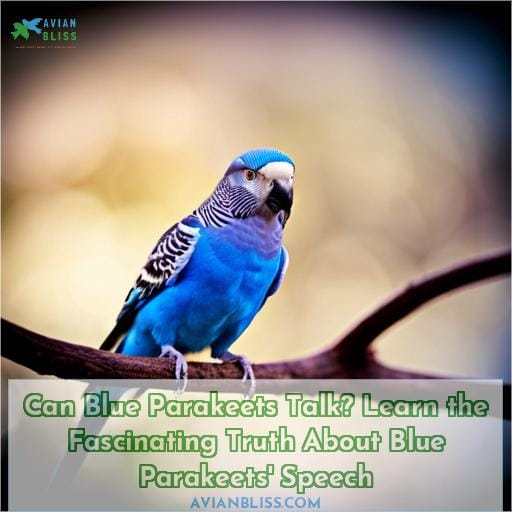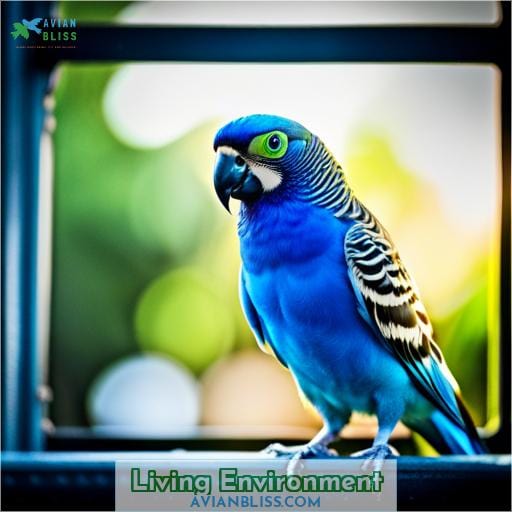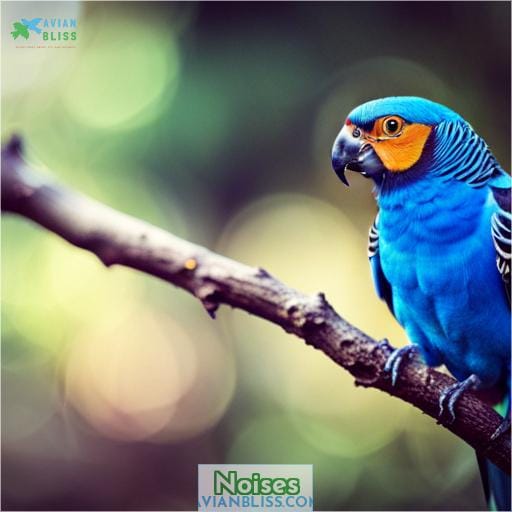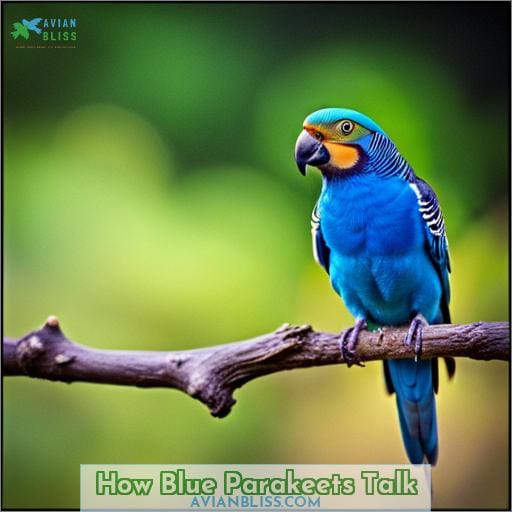This site is supported by our readers. We may earn a commission, at no cost to you, if you purchase through links.
 Curious to know if blue parakeets can talk? Let’s explore the fascinating truth about blue parakeets’ speech and how they communicate.
Curious to know if blue parakeets can talk? Let’s explore the fascinating truth about blue parakeets’ speech and how they communicate.
Table Of Contents
Key Takeaways
- Blue parakeets are known for their ability to talk and mimic sounds.
- They have an impressive vocabulary compared to other parrots, with some individuals able to learn up to 100 words or more.
- Blue parakeets start learning at a young age and refine their vocalizations through practice and repetition.
- They also rely on visual cues when learning new words or phrases, paying attention to both the sound and associated movements.
Origin and Appearance
Originating from Australia, blue parakeets are characterized by their blue feathers and black beaks.
Diet
Blue parakeets eat a diet of bird seed, fruits, and vegetables, just like other pet birds.
You should avoid feeding them avocado, chocolate, or caffeine, as these foods can be toxic to them.
You should also make sure to clean their food and water bowls regularly to prevent the growth of bacteria.
By feeding your blue parakeet a healthy diet, you can help them live a long and healthy life.
Living Environment
After providing your blue parakeet with a healthy diet, it’s crucial to ensure they’ve a comfortable living environment.
Blue parakeets thrive in spacious cages that meet their needs for movement and mental stimulation. The minimum cage size should be at least 2 feet wide, 2 feet deep, and 4 feet tall to allow ample room for flying and hopping around.
Place the cage in an area where your parakeet can interact with you and feel like part of the family.
To enhance their living space, add various cage accessories such as perches of different sizes and textures, swings for entertainment, toys to keep them mentally stimulated, and mirrors or bells that they can play with.
Cage cleaning is essential for maintaining a healthy living environment for your blue parakeet. Regularly remove any debris or droppings from the bottom of the cage using newspaper or bird-safe bedding material.
Additionally, clean food bowls regularly, wash water dishes daily, and disinfect perches, toys periodically with avian-safe cleaners.
To bond further, you can spend time near the cage talking, singing, and whistling to encourage your parakeet to participate in vocalizations. Bonding activities are crucial as blue parakeets are social animals and thrive on interaction.
In conclusion, the living environment plays an important role in promoting speech development among blue parakeets. Their cage should meet minimum size requirements while providing adequate accessories for stimulation.
Cage cleaning is essential to maintain healthy cage surroundings. Alongside a healthy diet and social interactions, living environment plays a crucial part in the development of speech skills among blue parakeets.
Cost
To properly care for a blue parakeet, it’s important to consider the cost of owning one.
The cost of blue parakeets can vary depending on where you purchase them. On average, they range from $22 to $100. This price may be influenced by factors such as the breeder, age, and color of the parakeet.
In addition to the initial cost of acquiring a blue parakeet, there are ongoing expenses that need to be taken into account.
One major expense is food. Blue parakeets require a nutritious diet consisting of bird seed, fruits, and vegetables.
To keep your feathered friend entertained and mentally stimulated, you’ll also need to invest in toys specifically designed for blue parakeets.
Another essential aspect when considering costs is providing an appropriate cage for your blue budgie companion.
The cage should have enough space for them to move around comfortably; typically at least 2 feet wide by 2 feet deep by 4 feet tall in size.
Furthermore, you must ensure proper hygiene within their living environment regularly cleaning out debris or waste from their cages.
Lastly, don’t forget about veterinary care! Regular check-ups with an avian veterinarian are crucial for maintaining your bird’s health.
Taking these measures won’t only contribute towards keeping up good physical condition but also mental stimulation leading towards better talking ability if birds do indeed learn how-to-talk.
Personality
Get to know the playful and talkative personality of blue parakeets. These charming birds have a multitude of traits that make them beloved companions.
- Playful: Blue parakeets are known for their playful nature, always finding joy in exploring their surroundings and interacting with toys or objects within their reach.
- Social: These birds thrive on social interaction, whether it’s with other parakeets or humans. They enjoy being part of a flock and can form strong bonds with their human caregivers.
- Curious: Blue parakeets have an innate sense of curiosity that drives them to explore new things around them. They love investigating different textures, colors, and sounds in their environment.
Intelligent: Despite their small size, blue parakeets possess remarkable intelligence.
Affectionate – Blue Parrotlets cultivate deep emotional connections with individuals they trust by showing affection through gentle nibbles (beak grinding) also called allopreening; preening one another’s feathers as well as providing comfort especially during stressful situations like molting season when feather loss is common.
These delightful creatures aren’t only talking but whistling wonders too! Their ability to mimic various sounds allows for endless entertainment as they fill your home with cheerful melodies.
So if you’re looking for a companion who’ll keep you entertained while showering you with affection throughout the day soon after waking up from sleep fl■ up all warm & cosy then look no further than these charismatic blue beauties
Noises
When it comes to noises, blue parakeets are known for their ability to produce a variety of sounds using their vocal cords and beaks. As an ornithologist, avian veterinarian, or bird breeder, you understand the significance of these noises in understanding the behavior and emotions of blue parakeets.
While talking is different from screaming, both play important roles in communication for these intelligent birds.
Blue parakeets use talking as a way to mimic human speech or other sounds they hear around them. They can learn words and phrases through repetition and training. On the other hand, screaming is often associated with fear or distress in blue parakeets.
When happy or contented, you may hear your blue parakeet producing pleasant chirps or melodic whistles. These sounds indicate their positive emotional state when they feel safe and secure in their environment.
However, if your feathered friend feels scared or threatened by something nearby such as loud noises or sudden movements; he might emit high-pitched screeches that signal his need for protection against perceived danger.
In moments when alone without any social interaction from humans or fellow birds; Blue Parrots sometimes make soft cooing sound equivalent to self-soothing which brings comfort during times loneliness
Beak grinding can also be heard occasionally- this could serve several purposes including maintaining healthy beak structure but mainly indicates relaxation。
It’s important to note that excessive noise-making behaviors like constant screaming shouldn’t be encouraged as it may lead towards unwanted consequences such as feather plucking which happens due stress-induced situations so always ensure proper care by providing adequate mental stimulation & attention while respecting boundaries!
How Blue Parakeets Talk
Blue parakeets communicate through vocalizations produced by their unique syrinx and the muscles in their beaks.
Here’s how blue parakeets learn to talk:
- Blue parakeets have an impressive vocabulary compared to other parrots, with some individuals able to learn up to 100 words or more.
- They start learning at a young age, listening closely and mimicking sounds they hear from their surroundings.
- Repetition is key for them as they practice and refine their vocalizations over time.
- Blue parakeets also rely on visual cues when learning new words or phrases, paying attention not only to the sound but also the movements associated with certain expressions.
In terms of intelligence, blue parakeets are highly capable learners. They possess cognitive abilities that allow them not only mimic human speech but also understand basic concepts and respond appropriately.
When it comes to lifespan, blue parakeets can live for up to 20 years if provided with proper care. This provides ample opportunity for owners who want a long-term companion that can engage in meaningful conversation.
Overall, the talking ability of blue parakeets showcases both their natural communication skills and adaptability as intelligent creatures within our avian world.
Frequently Asked Questions (FAQs)
Can blue parakeets talk in different languages?
Blue parakeets have the ability to mimic sounds, including different languages.
Through exposure and training, they can learn to imitate words and phrases in various tongues, showcasing their remarkable linguistic abilities.
Can blue parakeets mimic other animal sounds?
Blue parakeets have the ability to mimic other animal sounds, such as barks or meows.
Can blue parakeets learn to talk at any age?
Blue parakeets can learn to talk at any age. With patience, consistent interaction, and positive reinforcement, they’ve the potential to mimic sounds and even develop a vocabulary that will amaze you.
Can blue parakeets talk to each other in a way that humans can’t understand?
Blue parakeets have their own unique way of communicating with each other, using various vocalizations and body language. While humans may not fully understand their conversations, these interactions play a crucial role in their social dynamics and bonding.
Can blue parakeets have different accents or speech patterns when they talk?
Blue parakeets, like humans, have their own unique accents and speech patterns when they talk. It’s a delightful quirk that adds personality to these charming feathered friends.
Conclusion
Ultimately, while blue parakeets are known for their vibrant appearance and captivating personalities, their ability to talk isn’t their strongest suit.
While some blue parakeets may be able to mimic simple words or phrases, their speech capabilities are limited compared to other parrot species.
However, this shouldn’t discourage you from keeping a blue parakeet as a pet, as they make wonderful companions with their playful nature and ability to communicate through various sounds and gestures.
So, while blue parakeets may not be the best talkers, they still have plenty to say in their own unique way.










